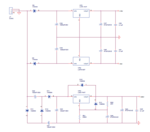Freehawk
Full Member level 2

Hi,
It´s not the schematic alone that makes good sound. Part selection, PCB layout, wiring, coupling to mains (earth), GND loops .. may also influence AC hum
No.
17V at the input at the voltage regulators does not mean the AC is 17V.
When one talks about AC voltage one usually means AC sine RMS.
The diode capacitor solution charges the capacitor to almost the peak value of the sine.
But the peak value of a sine is 1.414 x the RMS value of the sine.
12V AC RMS sine --> 17V peak sine. (positive as well as negative)
Subtract 1 V for the diode drop and another 0.5V for the capacitor voltage ripple then you may expect about 15.5V (with some load current)
(The exact value depends on a lot of things: Mains voltage, transformer, diode, capacitor value, load current, mains frequency....)
Maybe.
We professionals should do it the other way round.
* decide specifications for the preamp
* desgin preamp circuit
* decide specifications for the supply circuit
* design the supply circuit.
Klaus
Well i am not a professional
Otherwise i simply have nothing to test it with, i do not have a variable power source on my bench to use to test the circuit (no professional)
That's how my logic works.
Ok i agree it could be after designing the op-amp circuit that i have to adapt the supply circuit
but with +15/-15v it should be at least sufficient (i don't say ideal)

